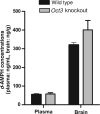Interaction of organic cation transporter 3 (SLC22A3) and amphetamine
- PMID: 20402963
- PMCID: PMC3775896
- DOI: 10.1111/j.1471-4159.2010.06738.x
Interaction of organic cation transporter 3 (SLC22A3) and amphetamine
Abstract
The organic cation transporter (OCT) 3 is widely expressed in various organs in humans, and involved in the disposition of many exogenous and endogenous compounds. Several lines of evidence have suggested that OCT3 expressed in the brain plays an important role in the regulation of neurotransmission. Relative to wild-type (WT) animals, Oct3 knockout (KO) mice have displayed altered behavioral and neurochemical responses to psychostimulants such as amphetamine (AMPH) and methamphetamine. In the present study, both in vitro and in vivo approaches were utilized to explore potential mechanisms underlying the disparate neuropharmacological effects observed following AMPH exposure in Oct3 KO mice. In vitro uptake studies conducted in OCT3 transfected cells indicated that dextroamphetamine (d-AMPH) is not a substrate of OCT3. However, OCT3 was determined to be a high-capacity and low-affinity transporter for the neurotransmitters dopamine (DA), norepinephrine (NE), and serotonin (5-HT). Inhibition studies demonstrated that d-AMPH exerts relatively weak inhibitory effects on the OCT3-mediated uptake of DA, NE, 5-HT, and the model OCT3 substrate 4-(4-(dimethylamino)styryl)-N-methylpyridinium iodide. The IC(50) values were determined to be 41.5 +/- 7.5 and 24.1 +/- 7.0 microM for inhibiting DA and 5-HT uptake, respectively, while 50% inhibition of NE and 4-(4-(dimethylamino)styryl)-N-methylpyridinium iodide uptake was not achieved by even the highest concentration of d-AMPH applied (100 microM). Furthermore, the disposition of d-AMPH in various tissues including the brain, liver, heart, kidney, muscle, intestine, spleen, testis, uterus, and plasma were determined in both male and female Oct3 KO and WT mice. No significant difference was observed between either genotypes or sex in all tested organs and tissues. Our findings suggest that OCT3 is not a prominent factor influencing the disposition of d-AMPH. Additionally, based upon the inhibitory potency observed in vitro, d-AMPH is unlikely to inhibit the uptake of monoamines mediated by OCT3 in the brain. Differentiated neuropharmacological effects of AMPHs noted between Oct3 KO and WT mice appear to be due to the absence of Oct3 mediated uptake of neurotransmitters in the KO mice.
Figures





Similar articles
-
Evaluation of organic cation transporter 3 (SLC22A3) inhibition as a potential mechanism of antidepressant action.Pharmacol Res. 2012 Apr;65(4):491-6. doi: 10.1016/j.phrs.2012.01.008. Epub 2012 Feb 8. Pharmacol Res. 2012. PMID: 22342816
-
Inhibition of organic cation transporter 2 and 3 may be involved in the mechanism of the antidepressant-like action of berberine.Prog Neuropsychopharmacol Biol Psychiatry. 2014 Mar 3;49:1-6. doi: 10.1016/j.pnpbp.2013.11.005. Epub 2013 Nov 15. Prog Neuropsychopharmacol Biol Psychiatry. 2014. PMID: 24246570
-
Selective transport of monoamine neurotransmitters by human plasma membrane monoamine transporter and organic cation transporter 3.J Pharmacol Exp Ther. 2010 Dec;335(3):743-53. doi: 10.1124/jpet.110.170142. Epub 2010 Sep 21. J Pharmacol Exp Ther. 2010. PMID: 20858707 Free PMC article.
-
Mechanisms of amphetamine action revealed in mice lacking the dopamine transporter.J Neurosci. 1998 Mar 15;18(6):1979-86. doi: 10.1523/JNEUROSCI.18-06-01979.1998. J Neurosci. 1998. PMID: 9482784 Free PMC article. Review.
-
Roles for the uptake2 transporter OCT3 in regulation of dopaminergic neurotransmission and behavior.Neurochem Int. 2019 Feb;123:46-49. doi: 10.1016/j.neuint.2018.07.008. Epub 2018 Jul 25. Neurochem Int. 2019. PMID: 30055194 Free PMC article. Review.
Cited by
-
Organic cation transporters in psychiatric and substance use disorders.Pharmacol Ther. 2024 Jan;253:108574. doi: 10.1016/j.pharmthera.2023.108574. Epub 2023 Dec 9. Pharmacol Ther. 2024. PMID: 38072333 Free PMC article. Review.
-
Organic Cation Transporter 3 Facilitates Fetal Exposure to Metformin during Pregnancy.Mol Pharmacol. 2018 Oct;94(4):1125-1131. doi: 10.1124/mol.118.112482. Epub 2018 Jul 16. Mol Pharmacol. 2018. PMID: 30012584 Free PMC article.
-
Influence of chronic amphetamine treatment and acute withdrawal on serotonin synthesis and clearance mechanisms in the rat ventral hippocampus.Eur J Neurosci. 2013 Feb;37(3):479-90. doi: 10.1111/ejn.12050. Epub 2012 Nov 14. Eur J Neurosci. 2013. PMID: 23157166 Free PMC article.
-
The Interaction of Organic Cation Transporters 1-3 and PMAT with Psychoactive Substances.Handb Exp Pharmacol. 2021;266:199-214. doi: 10.1007/164_2021_469. Handb Exp Pharmacol. 2021. PMID: 33993413 Review.
-
Substrates and Inhibitors of Organic Cation Transporters (OCTs) and Plasma Membrane Monoamine Transporter (PMAT) and Therapeutic Implications.Handb Exp Pharmacol. 2021;266:119-167. doi: 10.1007/164_2021_516. Handb Exp Pharmacol. 2021. PMID: 34495395
References
-
- Amphoux A, Vialou V, Drescher E, et al. Differential pharmacological in vitro properties of organic cation transporters and regional distribution in rat brain. Neuropharmacology. 2006;50:941–952. - PubMed
-
- Aoyama N, Takahashi N, Kitaichi K, et al. Association between gene polymorphisms of SLC22A3 and methamphetamine use disorder. Alcohol. Clin. Exp. Res. 2006;30:1644–1649. - PubMed
-
- Feng N, Mo B, Johnson PL, Orchinik M, Lowry CA, Renner KJ. Local inhibition of organic cation transporters increases extracellular serotonin in the medial hypothalamus. Brain Res. 2005;1063:69–76. - PubMed
Publication types
MeSH terms
Substances
Grants and funding
LinkOut - more resources
Full Text Sources
Molecular Biology Databases
Research Materials

